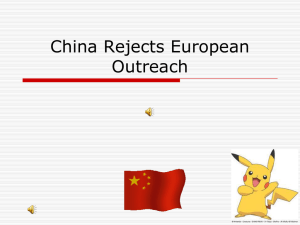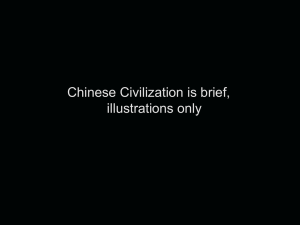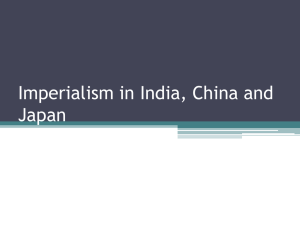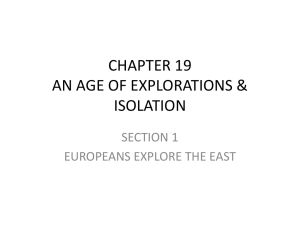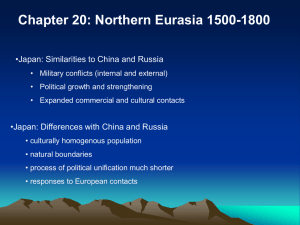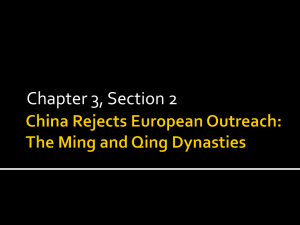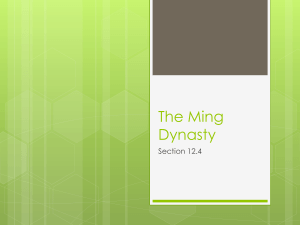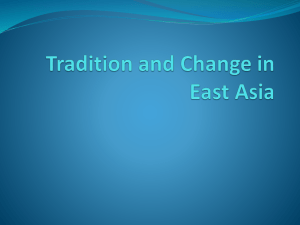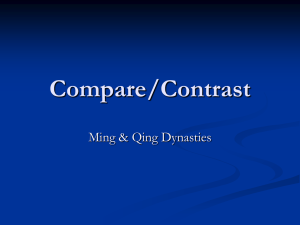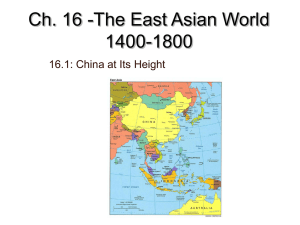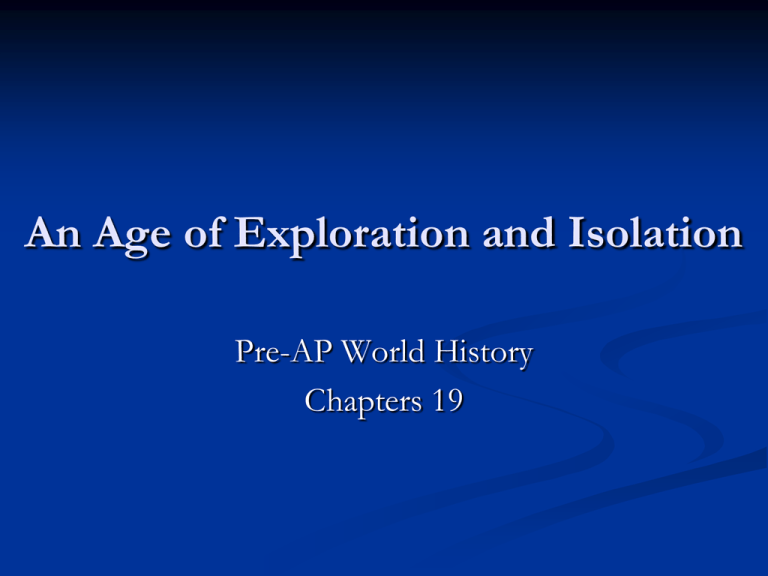
An Age of Exploration and Isolation
Pre-AP World History
Chapters 19
Bartolomeu Dias
Portuguese explorer who, in 1488, was the first European sea captain to sail
around the southern edge of Africa (The Cape of Good Hope.) Speaking on
behalf of all European navigators, Dias summarized the motives behind
exploration: “To serve God and His Majesty, to give light to those who were in
darkness (preach Christianity) & to grow rich as all men desire to do.”
Europeans had not been completely isolated from the rest of the world before the 1400s. Beginning around 1100, European
crusaders battled Muslims for control of the Holy Lands in Southwest Asia. In 1275, the Italian trader Marco Polo reached
the court of Kublai Khan in China. For the most part, however, Europeans had neither the interest nor the ability to explore
foreign lands. That changed by the early 1400s. The desire to grow rich and to spread Christianity, coupled with advances in
sailing technology, spurred an age of European exploration.
The desire for new sources of wealth was the main reason for European exploration. Through overseas exploration,
merchants and traders hoped ultimately to benefit from what had become a profitable business in Europe: the trade of
spices and other luxury goods from Asia. The people of Europe had been introduced to these items during the Crusades, the
wars fought between Christians and Muslims from 1096 to 1270. After the Crusades ended, Europeans continued to
demand such spices as nutmeg, ginger, cinnamon, and pepper, all of which added flavor to the bland foods of Europe.
Because demand for these goods was greater than the supply, merchants could charge high prices and make great profits.
The Muslims and the Italians controlled the trade of goods from East to West. Muslims sold Asian goods to Italian
merchants, who controlled trade across the land routes of the Mediterranean region. The Italian merchants resold the items
at increased prices to merchants throughout Europe. Other European traders did not like this arrangement. Paying such high
prices to the Italians severely cut into their own profits. By the 1400s, European merchants – as well as the new monarchs of
England, Spain, Portugal, and France – sought to bypass the Italian merchants. This meant finding a sea route to Asia.
Closure Question #1: What were the motives behind European exploration in the 1400s?
Explain.
Prince Henry
The son of Portugal’s king, in 1419 Henry founded a navigation school in the
southwestern coast of Portugal. Mapmakers, instrument makers, shipbuilders, scientists,
and sea captains gathered there to perfect their skills. Under his direction, Portugal
became the European leader in sailing & exploration in the 16th century, sailing south to
establish trading posts in Africa and, eventually, reaching India and the rest of Asia to
control the profitable spice trade.
While “God, glory, and gold” were the primary motives for exploration, advances in technology
made the voyages of discovery possible. During the 1200s, it would have been nearly impossible for
a European sea captain to cross 3,000 miles of ocean and return again. The main problem was that
European ships could not sail against the wind. In the 1400s, shipbuilders designed a new vessel,
the caravel. The caravel was sturdier than earlier vessels. In addition, triangular sails adopted from
the Arabs allowed it to sail effectively against the wind. Europeans also improved their navigational
techniques. To better determine their location at sea, sailors used the astrolabe, which the Muslims
had perfected. The astrolabe was a brass circle with carefully adjusted rings marked off in degrees.
Using the rings to sight the stars, a sea captain could calculate latitude, or how far north or south of
the equator the ship was. Explorers were also able to more accurately track direction by using a
magnetic compass, a Chinese invention.
The leader in developing and applying these sailing innovations was Portugal. Located on the Atlantic Ocean at the southwest corner of Europe. Portugal was
the first European country to establish trading outposts along the west coast of Africa. Eventually, Portuguese explorers pushed farther east into the Indian
Ocean. The nation’s most enthusiastic supporter of exploration was Prince Henry. Henry’s dreams of overseas exploration began in 1415 when he helped
conquer the Muslim city of Ceuta in North Africa. There, he had his first glimpse of the dazzling wealth that lay beyond Europe. In Ceuta, the Portuguese
invaders found exotic stores filled with pepper, cinnamon, cloves, and other spices. In addition, they encountered large supplies of gold, silver, and jewels.
Closure Question #2: In what ways did Europeans owe some of their sailing technology to
other peoples?
Vasco de Gama
Vasco de Gama – Portuguese sea captain who pioneered the route from Europe
south around the Cape of Good Hope (southern Africa) east to India, enabling
Portugal to control the Indian Spice Trade.
Portuguese fleets began probing southward along the western coast of Africa. There they discovered gold, renaming the
western African coast the Gold Coast. Portuguese warships defeated a combined fleet of Turkish and Indian ships in 1509.
In 1510 they set up a port at Goa, on the western coast of India. Melaka was a spice trade port on the Malay Peninsula
controlled by the Portuguese which gave them access to Asia and the Pacific Islands. Portuguese settlers signed a treaty with
local rulers for the purchase and export of cloves to the European market. This treaty established Portuguese control of the
Spice Trade.
Henry returned to Portugal determined to reach the source of treasures in the East. The prince also wished to spread the
Christian faith. Within several years, Portuguese ships began sailing down the western coast of Africa. By the time Henry
died in 1460, the Portuguese had established a series of trading posts along western Africa’s shores. There, they traded with
Africans for such profitable items as gold and ivory. Eventually, they traded for African captives to be used as slaves. Having
established their presence along the African coast, Portuguese explorers plotted their next move. They would attempt to find
a sea route to Asia.
The Portuguese believed that to reach Asia by sea, they would have to sail around the southern tip of Africa. In 1488,
Portuguese captain Bartolomeu Dias ventured far down the coast of Africa until he and his crew reached the tip. As they
arrived, a huge storm rose and battered the fleet for days. When the storm ended, Dias realized his ships had been blown
around the tip to the other side. Dias explored the southeast coast of Africa and then considered sailing to India. However,
his crew was exhausted and food supplies were low. As a result, the captain returned home.
Treaty of Tordesillas
Agreement between Spain and Portugal made in 1494; An imaginary line of
demarcation separated territory to be explored and controlled by each nation.
Spain would have authority over North and South America west of Brazil while
Portugal would have authority over Brazil, Africa, and all trade routes east.
Guangzhou was a Portuguese trading port in China, also known as Canton, established in the early 16 th century. In 1514 a
Portuguese fleet arrived off the coast of China. It was the first direct contact between the Chinese Empire and Europe since
the journeys of Marco Polo. At the time, the Ming government thought little of the arrival of the Portuguese. China was at
the height of its power as the most magnificent civilization no Earth. From the perspective of the emperor, the Europeans
were only an unusual form of barbarian. To the Chinese ruler, the rulers of all other countries were simply “younger
brothers” of the Chinese emperor, who was seen as the Son of Heaven.
The Portuguese soon outraged Chinese officials with their behavior. They were expelled from Guangzhou but were allowed
to occupy Macao, a port on the southeastern coast of China. At first, the Portuguese had little impact on Chinese society.
Portuguese ships did carry goods between China and Japan, but direct trade between Europe and China remained limited.
Perhaps more important than trade, however, was the exchange of ideas.
Christian missionaries had also made the long voyage to China on European merchant ships. The Jesuits, a Catholic order
that focused on education and establishing missions, were among the most active. Many of them were highly educated men
who brought along instruments, such as clocks, that impressed the Chinese officials and made them more receptive to
Western ideas. Both sides benefited from this early cultural exchange. Chinese scholars marveled at their ability to read
better with European eyeglasses. Christian missionaries were impressed with many aspects of Chinese civilization, the
printing and availability of books, and Chinese architecture.
Closure Question #3: What did the Treaty of Tordesillas reveal about Europeans’ attitudes
toward non-European lands and peoples?
Dutch East India Company
Powerful sea trading company established by the government of the
Netherlands; By 1600, the Dutch owned the largest fleet of ships in the world –
20,000 vessels, and dominated trade in Asia.
In the years following da Gama’s voyage, Portugal built a bustling trading empire throughout the Indian Ocean. As the
Portuguese moved into the region, they took control of the spice trade from Muslim merchants. In 1509, Portugal extended
its control over the area when it defeated a Muslim fleet off the coast of India, a victory made possible by the cannons they
had added aboard their ships. Portugal strengthened its hold on the region by building a fort at Hormuz in 1514. It
established control of the Straits of Hormuz, connecting the Persian Gulf and Arabian Sea, and helped stop Muslim traders
from reaching India.
In 1510, the Portuguese captured Goa, a port city on India’s west coast. They made it the capital of their trading empire.
They then sailed farther east to Indonesia, also known as the East Indies. In 1511, a Portuguese fleet attacked the city of
Malacca on the west coast of the Malay Peninsula. In capturing the town, the Portuguese seized control of the Strait of
Malacca. Seizing this waterway gave them control of the Moluccas. These were islands so rich in spices that they became
known as the Spice Islands. Portugal did break the old Muslim-Italian domination on trade from the East, much to the
delight of European consumers. Portuguese merchants brought back goods from Asia at about one-fifth of what they cost
when purchased through the Arabs and Italians. As a result, more Europeans could afford these items.
Beginning around 1600, the English and Dutch began to challenge Portugal’s dominance over the Indian Ocean trade. The
Dutch Republic, also known as the Netherlands, was a small country situated along the North Sea in northwestern Europe.
Since the early 1500s, Spain had ruled the area. In 1581, the people of the region declared their independence from Spain
and established the Dutch Republic. In a short time, the Netherlands became a leading sea power. Pressure from Dutch and
also English fleets eroded Portuguese control of the Asian region. The Dutch and English then battled one another for
dominance in the area.
Closure Assignment #4
1.
2.
3.
Answer the following questions based on what you
have learned from Chapter 19, Section 1:
What were the motives behind European exploration
in the 1400s? Explain.
In what ways did Europeans owe some of their
sailing technology to other peoples?
What did the Treaty of Tordesillas reveal about
Europeans’ attitudes toward non-European lands and
peoples?
Ming Dynasty
Ming – Chinese dynasty which overthrew the Mongols in 1368 and ruled until
1644; During the Ming Dynasty China gained control of Mongolia and
strengthened the Great Wall militarily while building factories and introducing
new crops economically and establishing a nationwide school system.
The founder of the Ming Dynasty was Ming Hong Wu (The Ming Martial Emperor). Under Ming emperors, China extended
its rule into Mongolia and central Asia and briefly reconquered Vietnam. Along the northern frontier, the Chinese
strengthened the Great Wall and made peace with the nomadic tribes that had troubled them for many centuries. At home,
Ming rulers ran an effective government using a centralized bureaucracy staffed with officials chosen by the civil service
examination system. They set up a nationwide school system. Manufactured good were produced in workshops and factories
in vastly higher numbers. New crops were introduced, which greatly increased food production. The Ming rulers also
renovated the Grand Canal, making it possible to ship grain and other goods from southern to northern China. The Ming
dynasty truly began a new era of greatness in Chinese history.
Porcelain was one of the most famous of Chinese arts and an important trading export during the Ming and Qing dynasties.
Blue and White designs on porcelain pots and plates were collected in great quantities by Europeans during the era. Ming
porcelain artists studied nature to perfect their skill in painting traditional scenes. Blue-and-white porcelain pieces were
created by artists who specialized in each step of the painting, glazing, and firing process. Jingdezhen is known as the
porcelain capital of the world. Porcelain was made there as early as about 200 B.C. during the Han dynasty. When the Ming
Dynasty was close to collapse, there was less domestic demand for porcelain; so Jingdezhen potters increased shipments to
foreign markets such as Japan and Europe. Soon Chinese porcelain was in worldwide demand.
Improvements in agriculture during the Ming dynasty caused great changes in Chinese society. As Ming traders ventured
into Southeast Asia, they acquired rice that produced much larger harvests. In the 1500s, American foods were introduced to
China, including the peanut, the sweet potato, and maize (corn). The increase in rice production brought many changes.
With a better food supply, peasants were now able to grow cash crops – crops produced for a profit – like cotton and indigo.
As a result, manufacturing and commerce increased. Chinese silk, cotton, tea, and porcelain were in demand around the
world, especially in Europe and America.
Hongwu
Commander of the Chinese rebel army which drove the Mongols out of China in
1368, establishing himself as the first emperor of the Ming Dynasty. During his
rule, Hongwu attempted to restore Confucian values to China and eliminate all
traces of Mongol culture.
Between1500 & 1800, China remained a mostly agricultural society. Nearly 85% of the people were small farmers.
Nevertheless, the Chinese economy was changing. The first change for China involved an increase in population from less
than 80 million in 1390 to more than 300 million at the end of the 1700s. The increase had several causes. These included a
long period of peace and stability under the early Qing dynasty and improvements in the food supply due to a faster growing
species of rice from Southeast Asia. The population increase meant that less land was available for each family. The imperial
court tried to make more land available by limiting the amount wealthy landowners could hold. By the 18 th century,
however, almost all the land that could be farmed was already being farmed. Shortages of land in rural areas led to unrest
and revolts.
Another change in this period was a steady growth in manufacturing and increased trade between provinces. Taking
advantage of the long era of peace and prosperity, merchants and manufacturers expanded their trade in silk, porcelain,
cotton goods, and other products. Despite the growth in trade and manufacturing, China did not develop the kind of
commercial capitalism that was emerging in Europe. Middle-class merchants & manufacturers in China were not as
independent as those in Europe. Trade and manufacturing remained under Chinese governmental control. Chinese society
was organized around the family. The family was expected to provide for its members’ needs, including the education of
children, support of unmarried daughters, and care of the elderly.
Hongwu used respected traditions and institutions to bring stability to China. For example, he encouraged a return to
Confucian moral standards. He improved imperial administration by restoring the merit-based civil service examination
system. Later in his rule, however, when problems developed, Hongwu became a ruthless tyrant. Suspecting plots against his
rule everywhere, he conducted purges of the government, killing thousands of officials.
Yonglo
Hongwu’s son and 2nd emperor of the Ming Dynasty beginning in 1398; Yonglo
continued many of his father’s policies, although he moved the royal court to
Beijing. He also launched the first voyage of Chinese exploration commanded
by Zheng He in 1405.
Cao Xuein, Author of The Dream of the Red Chamber, is China’s most distinguished popular novel. Published in 1791, Red
Chamber tells of the tragic love between 2 young people caught in the financial and moral downfall of a powerful Chinese
clan. The Ming economic expansion increased standards of living, providing many Chinese with money to purchase books.
Also, new innovations in paper manufacturing encouraged the growth of printing throughout China. During the Ming
dynasty, a new form of literature arose that evolved into the modern Chinese novel. Works in literary form were quite
popular, especially among well-to-do urban dwellers, One Chinese novel, The Golden Lotus, is considered by many to be the
first realistic social novel. The Golden Lotus depicts the corrupt life of a wealthy landlord in the late Ming period who cruelly
manipulates those around him for sex, money, and power.
The ideal family unit in Qing China was the extended family, in which as many as three or four generations lived under the
same roof. When sons married, they brought their wives to live with them in the family home. Unmarried daughters also
remained in the house, as did parents and grandparents. Chinese society held the elderly in high regard. Aging parents knew
they would be cared for in their home by their children. Women were considered inferior to men in Chinese society. Only
males could have a formal education and pursue a career in government or scholarship. Within the family, capable women
often played strong roles. Nevertheless, the wife was clearly subordinate to the husband.
Hongwu’s death in 1398 led to a power struggle. His son Yonglo emerged victorious. Yonglo continued many of his father’s
policies, although he moved the royal court to Beijing. Yonglo also had a far-ranging curiosity about the outside world. In
1405, before Europeans began to sail beyond their borders, he launched the first of seven voyages of exploration. He hoped
they would impress the world with the power and splendor of Ming China. He also wanted to expand China’s tribute system.
The Forbidden City
The capital city of the Ming Dynasty, Beijing, was rebuilt by Emperor Yong Le
between 1406 and 1424. The Imperial City (known today as the Forbidden City)
was built inside Beijing and was home to Chinese emperors for nearly 500 years.
A complex of palaces and temples which is the most outstanding example of
Chinese architecture during the Ming and Qing dynasties, the Forbidden City
remains a symbol of Chinese isolationism and power.
The Imperial City is an immense compound surrounded by 6.5 miles of walls. It includes a maze of private apartments and
offices, as well as stately halls for imperial audiences and banquets and spacious gardens. Because it was off-limits to
commoners, the compound was known as the Forbidden city.
In a marriage in China, the wife could not divorce her husband or inherit property. The husband, in contrast, could divorce
his wife if she did not produce sons. He could also take a second wife. Husbands were expected to provide support for their
wives and children. In many cases, the head of the family would also be responsible for providing for more than just his own
wife and children.
A feature of Chinese society that restricted the mobility of women was the practice of footbinding. The origins of
footbinding are not clear. Scholars believe it began among the wealthier class of women and was later adopted by all classes.
Bound feet were a status symbol. Women who had bound feet were more marriageable than those who did not; thus, there
was a status incentive as well as an economic incentive. An estimated one-half to two-thirds of the women in China bound
their feet.The process, begun in childhood, was very painful. Women who had their feet bound could not walk; they were
carried. Not all clans looked favorably on footbinding. Women who worked in the fields or in occupations that required
mobility did not bind their feet.
Zheng He
Muslim Chinese court official & navigator who led 7 voyages of exploration
between 1405 and 1433, visiting Southeast Asia, India, and the east coast of
Africa. From 40 to 300 ships sailed in each expedition. The fleets crews
numbered over 27,000 on some voyages, including sailors, soldiers, carpenters,
interpreters, accountants, doctors, and religious leaders. Everywhere Zheng He
went, he distributed gifts including silver and silk to show Chinese superiority.
As a result, more than 16 countries sent tribute to the Ming court.
Ming Hong Wu, founder of the dynasty, ruled from 1368 until 1398. After his death, his son Yong Le became emperor. This
was after a four-year campaign to defeat the rightful heir. To establish the legitimacy of his rule, Yong Le built large
monuments, strengthened the Great Wall, and restored Chinese rule and provincial authority over Vietnam.
During his reign, Yong Le also sent a series of naval voyages into the Indian Ocean that sailed as far west as the eastern
coast of Africa. Led by the court official Zheng He, 7 voyages of exploration were made between 1405 and 1433. On the
first voyage, nearly 28,000 men embarked on 62 ships. The largest ship was over 440 feet long (Columbus’ Santa Maria was
only 75 feet long.) The fleet passed through Southeast Asia and visited the western coast of India and the city-states of East
Africa. It returned with items unknown in China and with information about the outside world. The emperor was especially
fascinated by the giraffes from Africa, and he placed them in the imperial zoo.
The seven voyages by Zheng He led to enormous profits, which alarmed traditionalists within the bureaucracy. Some of
them held the Confucian view that trading activities were unworthy and that being a merchant was an inferior occupation.
Shortly after Yong Le’s death, the voyages were halted, never to be revived. One can only guess what a difference it would
have made if Zheng He’s fleet had reached the Americas before Columbus did.
Manchus
Manchus – A farming and hunting people who lived northeast of the Great Wall
of China in the area known today as Manchuria, which is the extreme northeast
portion of China.
By 1600, the Ming had ruled for more than 200 years, and the dynasty was weakening. Its
problems grew – ineffective rulers, corrupt officials, and a government that was out of
money. Higher taxes and bad harvests pushed millions of peasants toward starvation.
Civil strife and rebellion followed. Northeast of the Great Wall lay Manchuria. In 1644,
the Manchus, the people of that region, invaded China and the Ming Dynasty collapsed.
The Manchus seized Beijing, and their leader became China’s new emperor. As the
Mongols had done in the 1300s, the Manchus took a Chinese name for their dynasty, the
Qing Dynasty. They would rule for more than 260 years and expand China’s borders to
include Taiwan, Chinese Central Asia, Mongolia, and Tibet.
Many Chinese resisted rule by the non-Chinese Manchus. Rebellions flared up periodically for decades. The Manchus, however, slowly
earned the people’s respect. They upheld China’s traditional Confucian beliefs and social structures. They made the country’s frontier
safe and restored China’s prosperity. Two powerful Manchu rulers contributed greatly to the acceptance of the new dynasty. The first,
Kangxi, became emperor in 1661 and ruled from some 60 years. He reduced government expenses and lowered taxes. A scholar and
patron of the arts, Kangxi gained the support of intellectuals by offering them government positions. He also enjoyed the company of
the Jesuits at court. They told him about developments in science, medicine, and mathematics in Europe. Under his grandson Qianlong, who ruled from 1736 to 1795, China reached its greatest size and prosperity. An industrious emperor like his grandfather, Qianlong often rose at dawn to work on the empire’s problems. These included armed nomads on its borders and the expanding presence
of European missionaries and merchants in China.
Closure Question #1: What factors, both within China and outside its borders, contributed
to the downfall of the Ming Dynasty?
Qing Dynasty
Chinese Dynasty established in 1644 when an army of Manchus conquered
Beijing and the Ming Dynasty; the Qing Dynasty ruled China until 1911.
After a period of prosperity and growth, the Ming dynasty gradually began to decline. During the late 16 th century, internal
power struggles developed. Groups worked to gain sole power and to place one of their leaders as emperor. Their efforts
resulted in a series of weak rulers who were overpowered. Children, who had no control over their empire, were sometimes
placed on the throne. Such internal power struggles led to a period of government corruption. High taxes, caused in part by
this corruption, led to peasant unrest. Crop yields declined because of harsh weather.
In the 1630s, a major epidemic greatly reduced the population in many areas. One observer in a major city wrote, “There
were few signs of human life in the streets and all that was heard was the buzzing of flies.” The suffering caused by the
epidemic helped spark a peasant revolt led by Li Zicheng. The revolt began in central China and then spread to the rest of
the country. In 1644 Li and his forces occupied the capital of Beijing. When the capital fell, the last Ming emperor
committed suicide by hanging himself from a tree in the palace gardens. Many officials took their own lives as well. The
overthrow of the Ming dynasty created an opportunity for the Manchus. They conquered Li Zicheng’s army in capturing
Beijing in 1644.
Taiwan , an island just east of China, was taken by rebels against the Qing dynasty seized the island in the mid 1600s.
Though the rebels were eventually defeated on the mainland, the island eventually became its own nation. The queue was a
traditional Manchu hairstyle in which Chinese men shave their foreheads and braid their hair into a pigtail; To identify
rebels the Qing dynasty ordered all males to adopt the Queue. When some Chinese resisted their new rulers and seized the
island of Taiwan, the Manchu government prepared to attack them. To identify the rebels, the government ordered all males
to adopt Manchu dress and hairstyles. They had to shave their foreheads and braid their hair into a pigtail called a queue.
Those who refused were assumed to be rebels and were executed: “Lose your hair or lose your head.”
The Manchus were gradually accepted as legitimate rulers. The Qing flourished under a series of strong early rulers. The
emperors pacified the country, corrected serious social and economic ills, and restored peace and prosperity. The Qing
maintained the Ming political system but faced one major problem: the Manchus were ethnically and culturally different
from their subject population. The Qing rulers dealt with this reality by preserving their distinct identity within Chinese
society and bringing Chinese into the imperial administration.
Closure Question #2: Do you think Lord George Macartney should
have kowtowed to Emperor Qian-long? Why?
To the Chinese, their country – called the Middle Kingdom – had been the
cultural center of the universe for 2,000 years. If foreign states wished to trade
with China, they would have to follow Chinese rules. These rules included
trading only at special ports and paying tribute.
The Dutch were masters of the Indian Ocean trade by the time of Qian-long.
They accepted China’s restrictions. Their diplomats paid tribute to the emperor
through gifts and by performing the required “kowtow” ritual. This ritual
involved kneeling in front of the emperor and touching one’s head to the ground
nine times. As a result, the Chinese accepted the Dutch as trading partners. The
Dutch returned home with traditional porcelains and silk, as well as a new trade
item, tea. By 1800, tea would make up 80% of shipments to Europe.
Great Britain hoped to increase trade with China. But the British did not like
China’s trade restrictions. In 1793, Lord George Macartney delivered a letter
from King George II to Qian-long. It asked for a better trade arrangement,
including Chinese acceptance of British manufactured goods. Macartney
refused to kowtow, and Qian-long denied Britain’s request. As the emperor
made clear in a letter to the king, China was self-sufficient and did not need the
British.
Kangxi
Qing Emperor who ruled China from 1661 to 1722; Kangxi was a strong military
leader and a supporter of art and literature. He granted religious freedom to his
people, allowing Christian missionaries to preach in the country.
Banners were Manchu military units which served as the chief fighting force of the Qing Empire. The Manchus, who made
up only 2% of the population, were defined legally as distinct from everyone else in China. The Manchu nobility maintained
large land-holdings and received revenues from the state treasury. Other Manchus were organized into separate military units
, called banners. The Qing dealt with the problem of ethnic differences by bringing Chinese into the imperial administration.
Chinese held more than 80% of lower posts, but they held a much smaller share of the top positions. Sharing of power won
many Chinese supporters to the Manchus.
Kangxi was perhaps the greatest of the many strong emperors who ruled China during the Ming and Qing dynasties. A
person with political skill and a strong character, Kangxi took charge of the government while still in his teens and reigned
for 61 years. Kangxi rose at dawn and worked until late at night. He wrote: “One act of negligence may cause sorrow all
through the country, and one moment of negligence may result in trouble for thousands of generations.” He calmed unrest
along the northern and western frontiers by force. As a patron of the arts and letters, he gained the support of scholars
throughout the country.
Qianlong was a Qing emperor who ruled China from 1736 to 1795; He expanded China to its greatest physical size &
oversaw greatest economic prosperity during the Qing dynasty. Towards the end of his reign the Qing dynasty began to fall
apart due to corrupt officials, high taxes, and peasant rebellion. As the emperor grew older, he fell under the influence of
destructive elements at court. Corrupt officials and higher taxes led to unrest in rural areas. Population growth also exerted
pressure on the land and led to economic hardship. In central China, unhappy peasants launched a revolt, the White Lotus
Rebellion (1796-1804). The revolt was suppressed, but the expenses of fighting the rebels weakened the Qing dynasty.
Closure Question #3: What was Korea’s
relationship with China under the Qing Dynasty?
In 1636, even before they came to power in China, the Manchus
conquered nearby Korea and made it a vassal state. As a member
of the Chinese tribute system, Korea had long existed in China’s
shadow. Koreans organized their government according to
Confucian principles. They also adopted China’s technology, its
culture, and especially its policy of isolation.
When the Manchus established the Qing dynasty, Korea’s political
relationship with China did not change. But Korea’s attitude did.
The Manchu invasion, combined with a Japanese attack in the
1590s, provoked strong feelings of nationalism in the Korean
people. This sentiment was most evident in their art. Instead of
traditional Chinese subjects, many artists chose to show popular
Korean scenes.
Closure Question #5
1.
2.
3.
Answer the following questions based on what
you have learned from Chapter 19, Section 2:
What factors, both within China and outside its
borders, contributed to the downfall of the
Ming Dynasty?
Do you think Lord George Macartney should
have kowtowed to Emperor Qian-long? Why?
What was Korea’s relationship with China
under the Qing Dynasty?
Daimyo
Japanese warrior-chieftains who, between 1467 and 1568, seized control of old
feudal estates, offering peasants and others protection in return for their loyalty.
In this new kind of feudalism, security came from the daimyo and the emperor
at Kyoto became a figurehead, having a leadership title but no actual power.
The new Japanese feudalism resembled European feudalism in many ways. The daimyo built fortified castles and created
small armies of samurai on horses. Later they added foot soldiers with muskets (guns) to their ranks. Rival daimyo often
fought each other for territory. This led to disorder throughout the land. A number of ambitious daimyo hoped to gather
enough power to take control of the entire country. One, the brutal and ambitious Oda Nobunaga, defeated his rivals and
seized the imperial capital Kyoto in 1568.
Following his own motto “Rule the empire by force,” Nobunaga sought to eliminate his remaining enemies. These included
rival daimyo as well as wealthy Buddhist monasteries aligned with them. In 1575, Nobunaga’s 3,000 soldiers armed with
muskets crushed an enemy force of samurai cavalry. This was the first time firearms had been used effectively in battle in
Japan. However, Nobunaga was not able to unify Japan. He committed seppuku, the ritual suicide of a samurai, in 1582, when
one of his own generals turned on him.
Nobunaga’s best general, Toyotomi Hideyoshi, continued his fallen leader’s mission. Hideyoshi set out to destroy the
daimyo that remained hostile. By 1590, by combining brute force with shrewd political alliances, he controlled most of the
country. Hideyoshi did not stop with Japan. With the idea of eventually conquering China, he invaded Korea in 1592 and
began a long campaign against he Koreans and their Ming Chinese allies. When Hideyoshi died in 1598, his troops withdrew
from Korea.
Closure Question #1: Why do you think that the emperor had less power than a shogun?
Oda Nobunaga
Daimyo whose forces seized the imperial capital of Kyoto and placed the
reigning shogun under his control in 1582 A.D. Following his motto “Rule the
empire by force”, Nobunaga sought to eliminate his enemies, including rival
daimyo and Buddhist monasteries. He failed in his mission to unify Japan,
committing ritual suicide in 1582 when one of his generals turned on him.
As the three great commanders were unifying Japan, the first Europeans began to arrive. Portuguese traders landed on the
islands in 1543. In a few years, Portuguese ships began stopping regularly at Japanese ports to take part in the regional trade
between Japan, China, and Southeast Asia. At first the visitors were welcomed. The Japanese were fascinated by tobacco,
clocks, eyeglasses, and other European goods. Nobunaga and Hideyoshi especially found the new firearms helpful in
defeating their enemies and unifying the islands under their rule.
A local daimyo, Lord Tokitaka, acquired firearms from the Portuguese almost immediately after their landing in 1543.
Within a few years, they were being mass-produced in Japan. Lord Tokitaka was in awe of the new weapons: “To use it, fill it
with powder and small lead pellets. Set up a small target on a bank. Grip the object in your hand, compose your body, and
closing one eye, apply fire to the opening. Then the pellet hits the target squarely. The explosion is like lightning and the
report like thunder… This thing with one blow can smash a mountain of silver and a wall of iron. If one sought to do
mischief in another man’s domain, and he was touched by it, he would lose his life instantly…” – Lord Tokitaka.
One of Hideyoshi’s strongest daimyo allies, Tokugawa Ieyasu, completed the unification of Japan. In 1600, Ieyasu defeated
his rivals at the Battle of Skigahara. His victory earned him the loyalty of daimyo throughout Japan. Three years later, Ieyasu
became the sole ruler, or shogun. He then moved Japan’s capital to his power base at Edo, a small fishing village that would
later become the city of Tokyo.
Toyotomi Hideyoshi
Japanese farmer’s son who became a military commander of Oda Nobunaga’s
army in the 1580s and moved the imperial capital to Osaka. By 1590, he had
persuaded most of the daimyo (heads of noble families) on the Japanese islands
to accept his authority.
European merchants were the next to go. Only a small Dutch (Netherlands) community was allowed to remain in Japan.
Dutch ships were permitted to dock at Nagasaki harbor only once a year and could remain for only two or three months.
The Tokugawa rulers established control of the feudal system that had governed Japan for over 300 years. As before, the
state was divided into about 250 separate territories called hans, or domains. Each was ruled by a daimyo. In theory, the
daimyo were independent because they were able to support themselves from taxes on their lands. In actuality, the
shogunate controlled the daimyo by a hostage system.
The emperor and imperial court families were at the very top of the political and social structure. Next came the warrior
class – the shogun, daimyo, samurai, and ronin. The shogun was supreme ruler below the emperor and distributor of the
national rice crop. The local daimyo received land and rice from the shogun in exchange for military service. Samurai
received rice from the daimyo in exchange for their services as advisers, castle guards, and government officials. Finally, the
ronin were warriors who had no masters and who traveled the countryside seeking jobs. Below the warriors were the
farmers, artisans, and merchants. Farmers produced rice and held a privileged position in society but were often poor. The
artisan class included craftspeople such as sword makers and carpenters. Merchants distributed food and essential goods.
Japan was unified, but the daimyo still governed at the local level. To keep them from rebelling, Ieyasu rquired that they
spend every other year in the capital. Even when they returned to their lands, they had to leave their families behind as
hostages in Edo. Through this “alternate attendance policy” and other restrictions, Ieyasu tamed the daimyo. This was a
major step toward restoring centralized government to Japan. As a result, the rule of law overcame the rule of the sword.
Tokugawa Shogunate
Tokugawa Ieyasu, head of the powerful daimyo of Edo (modern-day Tokyo),
took control of Japan in 1598. Ieyasu took the title of shogun in 1603, completing
the restoration of central authority begun by Nobunaga and Hideyoshi and
establishing the Tokugawa clan as the ruling authority in Japan.
Tokugawa shoguns remained in power at their capital at Edo until 1868, a long period that became known as the “Great
Peace.”During this long period of peace the samurai who had served the daimyo gradually cased to be a warrior class. Many
became managers on the daimyo’s lands. A major economic change took place under the Tokugawa. Since the 14 th century,
many upper-class Japanese, influenced by Confucianism, had considered trade and industry beneath them. Under the
Tokugawa rulers, however, trade and industry began to flourish as never before, especially in the growing cities of Edo,
Kyoto, and Osaka.
By 1750, Edo had a population of over a million and was one of the largest cities in the world. Banking flourished, and
paper money became the normal medium of exchange in business transactions. A Japanese merchant class emerged and
began to play a significant role in the life of the Japanese nation. What effect did these economic changes have on Japanese
peasants who made up most of the population? Some farm families benefited by exploiting the growing demand for cash
crops (crops grown for sale). Most peasants, however, experienced both declining profits and rising costs and taxes. Many
were forced to become tenants or to work as hired help. When rural conditions became desperate, some peasants revolted.
Almost 7,000 peasant revolts took place in the Tokugawa Era.
Hans were Separate territories, or domains, within Japan. During the Tokugawa Era there were about 250 separate hans.
Under the Hostage System under the Tokugawa Shogunate each daimyo was required to maintain two residences – one in
their own lands and one in Edo. When the daimyo left Edo, his family was forced to stay home as insurance for the
daimyo’s loyalty to the shogun. Eta, the lowest social class in Tokugawa Japan, endured laws which regulated where they
could live, how they could dress, and even what hairstyles they could use.
Haiku
5-7-5-syllable, 3-line verse poetry originated in Japan under the Tokugawa
Shogunate. Haiku poetry presents images rather than ideas. For example,
Matsuo Basho, the greatest haiku poet, wrote before his death in 1694:
“On a journey, ailing- / My dreams roam about / Over a withered moor.”
Matsuo Basho is viewed by many as the greatest Japanese poet. Basho wrote exquisite poetry about nature in the 17 th
century. Especially in the samurai class where Confucian values were highly prized, the rights of females were restricted.
Male heads of households had broad authority over property, marriage, and divorce. Among the common people, women
were also restricted. Parents arranged marriages, and a wife had to move in with her husband’s family. A wife who did not
meet the expectations of her husband or his family was likely to be divorced. Still, women were generally valued for their
roles as childbearers and homemakers among the common people. Women worked the fields as well, although men typically
did the heavier labor.
In the Tokugawa Era, a new set of cultural values began to appear, especially in the cities. It included the rise of popular
literature written by and for the people. The best examples of the new urban fiction are from Ihara Saikaku, considered one
of Japan’s greatest writers. Saikaku’s greatest novel, Five Women Who Loved Love, tells of a search for love by five women.
Those five women of the merchant class are willing to die for love – and all but one eventually do. Much popular literature
of the Tokugawa Era was lighthearted and intended to please its audiences. Poetry remained a more serious form of literary
expression.
Tokugawa culture was very structured. The emperor had the top rank but was just a figurehead. The actual ruler was the
shogun, who was the supreme military commander. Below him were the daimyo, the powerful landholding samurai. Samurai
warriors came next. The peasants and artisans followed them. Peasants made up about four-fifths of the population.
Merchants were at the bottom, but they gradually became more important as the Japanese economy expanded.
Kabuki
A new world of entertainment in the city of Edo gave rise in the theater to
Kabuki, which emphasized action, music, and dramatic gestures to entertain its
viewers. Early Kabuki dramas dealt with the world of teahouses and dance halls
in the cities. Government officials feared that exposure to these subjects onstage
might corrupt the moral standards of its people. They therefore forbade women
to appear on stage. The result was that a new profession was created – male
actors who portrayed female characters on stage.
In Japan, as in China, Confucian values influenced ideas about society. According to Confucius, the ideal society depended
on agriculture, not commerce. Farmers, not merchants, made ideal citizens. In the real world of Tokugawa Japan, however,
peasant farmers bore the main tax burden and faced more difficulties than an other class. Many of them abandoned farm life
and headed for the expanding towns and cities. There, they mixed with samurai, artisans, and merchants. By the mid-1700s,
Japan began to shift from a rural to an urban society. Edo had grown from a small village in 1600 to perhaps the largest city
in the world. Its population was more than 1 million. The rise of large commercial centers also increased employment
opportunities for women. Women found jobs in entertainment, textile manufacturing, and publishing. Still, the majority of
Japanese women led sheltered and restricted lives as peasant wives. They worked in the fields, managed the household, cared
for the children, and each woman obeyed her husband without question.
Europeans began coming to Japan in the 16th century, during the Warring States period. Despite the severe disorder in the
country, the Japanese welcomed traders and missionaries, from Portugal and later, other European countries. These
newcomers introduced fascinating new technologies and ideas. Within a century, however, the aggressive Europeans had
worn out their welcome.
Francis Xavier
The first Jesuit missionary to visit Japan, Francis Xavier, arrived in 1549. The
Jesuits converted a number of local daimyo. By the end of the 16th century,
thousands of Japanese had become Christians. However, after the Jesuits
destroyed local shrines, Hideyoshi issued an edict in 1587 prohibiting Christian
activities within his lands. The edict was at first not strictly enforced, and the
Jesuits were allowed to continue their activities. Under Ieyasu, however, all
missionaries were expelled, and Japanese Christians were persecuted.
The Japanese first encountered Europeans in 1543, when shipwrecked Portuguese sailors washed up on the shores of
southern Japan. Portuguese merchants soon followed. They hoped to involve themselves in Japan’s trade with China nad
Southeast Asia. The Portuguese brought clocks, eyeglasses, tobacco, firearms, and other unfamiliar items from Europe.
Japanese merchants, eager to expand their markets, were happy to receive the newcomers and their goods. The daimyo, too,
welcomed the strangers. They were particularly interested in the Portuguese muskets and cannons, because every daimyo
sought an advantage over his rivals.
The Japanese purchased weapons from the Portuguese and soon began their own production. Firearms forever changed the
time-honored tradition of the Japanese warrior, whose principal weapon had been the sword. Some daimyo recruited and
trained corps of peasants to use muskets. Many samurai, who retained the sword as their principal weapon, would lose their
lives to musket fire in future combat. The cannon also had a huge impact on warfare and life in Japan. Daimyo had to build
fortified castles to withstand the destructive force of cannonballs. The castles attracted merchants, artisans, and others to
surrounding lands. Many of these lands were to grow into the towns and cities of modern Japan, including Edo (Tokyo),
Osaka, Himeji, and Nagoya.
Closure Question #2: Why did the Japanese policy toward Christians change from
acceptance to repression?
Closure Question #3: Do you think Japan’s closed country policy
effectively kept Western ideas and customs out of Japan?
The persecution of Christians was part of an attempt to control foreign ideas.
When Europeans first arrived, no central authority existed to contain them. The
strong leaders who later took power did not like the introduction of European
ideas and ways, but they valued European trade. As time passed, the Tokugawa
shoguns realized that they could safely exclude both the missionaries and the
merchants. By 1639, they had sealed Japan’s borders and instituted a “closed
country policy.”
Most commercial contacts with Europeans ended. One port, Nagasaki,
remained open to foreign traders. But only Dutch and Chinese merchants were
allowed into the port. Earlier, the English had left Japan voluntarily; the Spanish
and the Portuguese had been expelled. Since the Tokugawa shoguns controlled
Nagasaki, they now had a monopoly on foreign trade, which continued to be
profitable.
For more than 200 years, Japan remained basically closed to Europeans. In
addition, the Japanese were forbidden to leave, so as not to bring back foreign
ideas. Japan would continue to develop, but as a self-sufficient country, free
from European attempts to colonize or to establish their presence.
Closure Assignment #6
1.
2.
3.
Answer the following questions based on what you
have learned from Chapter 19, Section 3:
Why do you think that the emperor had less power
than a shogun?
Why did the Japanese policy toward Christians
change from acceptance to repression?
Do you think Japan’s closed country policy
effectively kept Western ideas and customs out of
Japan?

